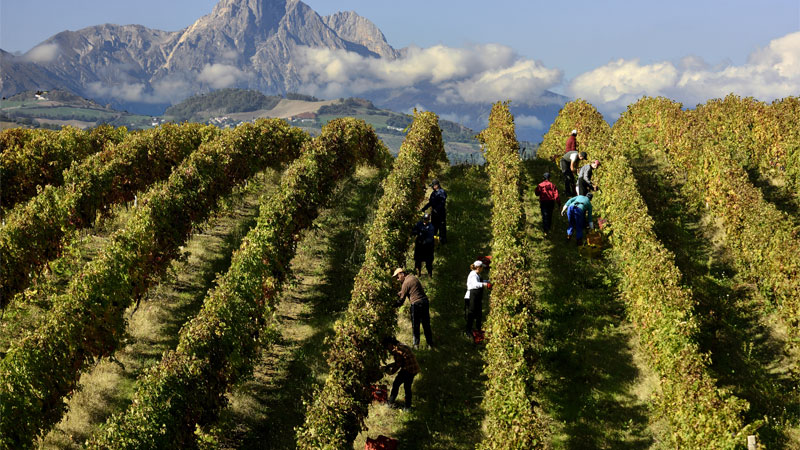
The first thing that comes to mind when you hear “Pecorino” is likely “Romano” (or Toscano or Sardo, if you know and love your cheeses). But the name of everyone’s favorite piquant-to-the-core cheese is shared with another Italian comestible: a crisp, aromatic white wine.
Once you get to know it — and you’ll want to get to know it — Pecorino will find its place in your heart alongside big-name white wines like Sauvignon Blanc and Pinot Grigio. It’s the kind of grape that can be approachably youthful or age-worthy and complex. But before we get into how many bottles to buy, a few notes about this new, other Pecorino.
The Grape
A small, delicately pale grape, Pecorino is happy from higher mountain altitudes all the way down to hillside slopes to the coast, and thrives in Italy’s Abruzzo region (although you’ll also find it in Marche, Umbria, Liguria, and Tuscany). The grape itself has an exceptionally high sugar content and tends to reflect the terroir without reserve — it’s both sensitive and expressive, not unlike Pinot Noir, so it’s a grape for a patient, dedicated winemaker.
The History
Pecorino’s exact history isn’t known, but it’s most certainly a native Italian grape, a centuries-old winemaking variety that fell into obscurity before its revival in the 1990s — and only then because the grape can be difficult to grow, both a low-yielder and fickle from season to season, and easier grapes were flooding the market. Thankfully, Pecorino is coming back in a big way, in large part because trailblazing winemakers realized its potential in time to pluck it from obscurity. And it’s a fairly recent revival: The first varietal bottle of Pecorino (called “Pecorino”) was produced in Abruzzo in 1996.
The Region
The exact birthplace of the Pecorino grape is unknown, but it flourishes in the Abruzzo region — roughly speaking, the central calf of the eastern side of the boot, bordered by the Apennine Mountains to the west and the Adriatic Sea to the east. Abruzzo has an almost mystical relationship to the grape, with its higher rocky slopes and lower coastal influence producing some of the most complimentary growing conditions for its “finicky” nature. Not only does that setting make for some of Italy’s most stunning winemaking territory, but the grapes benefit from a mosaic of microclimates. The territory is made up of clay, limestone, and gravel soils, and benefits from maritime influence, altitude, and cooling winds. No surprise, as of the end of 2019, Abruzzo has nearly 3,000 acres of Pecorino (and counting).

The Name
Since Pecorino — the wine — is obviously going to have a presence in your life now, you’ll want to be able to explain the name when people ask if it’s “cheese wine” (which, no…). One likely origin of the name comes from something called the “transumanza,” or the route Abruzzo shepherds would take their sheep every September into the 1950s, going from the mountains of Abruzzo south to Puglia. Since Pecorino grapes ripen early, they would have been available for traveling sheep to munch on during the transumanza. And since “pecora” means “sheep,” the grape could be named after the hungry creatures that made a snack of them. (Although that legend goes further, suggesting the shepherds would actually compensate vineyard owners for lost grapes during the transumanza with wedges of Pecorino cheese. Not a bad trade.)
The Wines
Clearly, the sheep were onto something. Pecorino grapes are delicious because they’re sweet and so can make decently high- alcohol wines. But the grape isn’t just sweet — in fact, the sugar content is beautifully balanced by bracing acidity and complex minerality, making Pecorino a prime candidate for age-worthy wines. But the other beautiful thing about Pecorino — for white wine lovers especially — is the complexity you can find in a relatively young, affordable bottle. In a similarly priced Pecorino, you’ll get much more than a two-dimensionally crisp Pinot Grigio or slatey Sauvignon Blanc; you get character, noticeable terroir, a richer flavor profile than often accompanies “fresh” white wines — notes of soft fruit, florals, dry herb, minerality, all balanced by freshening acid and a slightly heavier mouthfeel (thank you, sugar). Put simply, Pecorino is tremendous bang-for-your-buck wine (in a market that hasn’t quite caught up with that value yet) but you can just as easily find higher-end bottles that cost $200, complete with a “Provenance Guarantee.” It’s boutique, deservedly so.
As for what to expect in the bottle, the beauty of Pecorino is its versatility: It can go unoaked, or take a kiss of oak; and it can land soft on the palate with stone-fruit sweetness overlaid by florals and delicate herbal notes, with lively bracing acidity and even sometimes an almost saline minerality, depending on the bottle (and the variation is worth exploring, vineyard to vineyard). The alcohol can creep up to as much as 14 percent, but treat such a wine like you would a big moody red, making it prime for winter sipping with a nice cheese board and some prosciutto or dry figs or maybe an herbed pork roast — subtly sweet, nutty, savory.
The Pairings
Speaking of what to eat with Pecorino wine, in addition to pork products, and no, this not a joke: Pecorino wine pairs very well with Pecorino cheese. There’s something about the salty, nutty-tart cheese and the bracing acidity and fleshy stone fruit of the wine that make them a genuinely great pair. But Pecorino wines also go beautifully with fish and shellfish (summer grilling’s new best friend), and those dry soft herbal notes found in some bottles make them a natural match for complex, wintry flavors. Bottle to bottle, as ever, find what speaks to you.
Here are some of the Pecorino wines you need to try!
- Agricosimo – Pecorino Colline Teatine IGT: Notes of lemon and mint with a hint of herbs on the nose.
- Barone di Valforte – Abruzzo DOC Pecorino: This wine has a neutral nose with a hint of citrus and white flowers. It is tart on the palate.
- Cantina Miglianico – Abruzzo Pecorino DOP: This wine is minty and oxidized with a hint of butterscotch.The palate is soft with low acidity.
- Casal Thaulero – Pecorino Terre di Chieti I.G.T.: Notes of lemon and wet stone with a touch of creaminess. Calm and low acidity, with a balanced and broad palate.
- Cascina del Colle (Aimè) – Abruzzo Pecorino Superiore d’Abruzzo DOC BIO: Mineral nose with a touch of citrus. The palate is clean and crisp with neutral and balanced acidity.
- Ciavolich – Colline Pescaresi IGP Pecorino 2018: Notes of basil leaf and lemongrass with some rosemary. A well-structured and balanced wine.
- Contesa – Abruzzo DOC Pecorino: Lemon and wet stone with some chalk and white flowers on the nose. A balanced palate with lemon, curd, and herbs.
- Costantini – Aburzzo Pecorino DOC: Herby nose with a whiff of citrus. The palate has depth and is unique.
- Fontefico – Abruzzo Pecorino Superiore DOC: Honeysuckle and lavender with a hint of salty French butter.Exceptional palate with great acidity.
- Il Feuduccio – Pecorino Colline Teatine IGT: Rich, tart, and grippy palate with soft acidity and aromas carried throughout.
- Illuminati – V.Q.P.R.D. Controguerra D.O.C. Pecorino: Notes of lemon and wet stone or yogurt. Ripe apples on the palate with a touch of creaminess.
- La Valentina – Pecorino Colline Pescaresi IGT 2018: Notes of bright lemon and white flowers. This wine is soft and broad with zippy acidity.
- Marchesi di Cordano – Pecorino Colline Pescaresi IGP: Clean mineral and herbal notes, this wine is very well balanced and is a classic style.
- Novaripa – Abruzzo DOC Pecorino: Notes of lemon and mineral rock, with slight herbal notes. This wine has a honeyed palate with low acidity.
- San Lorenzo – Abruzzo DOC Pecorino: Notes of mint with lemon and honey. The palate is ripe with candied citrus.
- Talamonti – Pecorino Colline Pescaresi IGT: The palate is soft with good acidity and a grippy finish.
- Tenuta Cerulli Spinozzi – Pecorino Colli Aprutini IGT: Notes of lemon and pear. A very nice balance and clean finish, with great acid and some aloe.
- Valori – Abruzzo Pecorino DOC: Honeysuckle and lemon curd, with wet stone and slight herbs. Crisp minerality and great acidity.
- Cirelli – Colline Pescaresi Pecorino IGP 2018: Notes of savory herbs and mint. Soft acidity and a creamy palate with apples and herbs.
- Citra – Pecorino IGP Terre di Chieti: Clean and grippy with soft acidity and a comfortable mouthfeel.
This article is sponsored by Consorzio d’Abruzzo.

